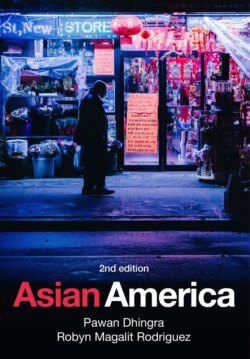Читать книгу Asian America - Pawan Dhingra - Страница 40
Sexuality and intersections of race and gender
ОглавлениеSexuality is a political issue, even outside of issues related to homosexuality. It is politicized in that it is tied to resources. Sex serves not simply as an act of attraction or love but has been tied to conquest and power, and intersects with gender and race simultaneously (Nagel 2003). For instance, the colonization of Native Americans by European Americans did not take place simply in the name of land acquisition. Native American men and women were framed as sexually deviant and needing to be tamed. British colonizers and US slave owners framed African men as hypersexual and with many wives – that is, of perverse sexuality – that must be saved or at least segregated. Asian men were framed as effeminate and unable to control their women, which made them inept at constructing a proper civilization and attending to their land (Okihiro 1994). Middle Eastern societies were framed as intolerant of women’s political, cultural, and sexual freedoms and so must be “liberated” by the US military. Colonization was an act of benevolence from this perspective. Though colonial encounters were ostensibly motivated by an interest in spreading Christian heteronormative morals to “savages,” they were at times also motivated by homosexual interests (Aldrich 2002). Colonial expeditions sometimes involved homosexual encounters between colonialists and “natives.”
Beyond colonization and slavery, race relations in the United States have been legislated along sexual lines. At the macro level, anti-miscegenation laws prohibited unions between whites and nonwhites as a means of “preserving” whiteness, and ultimately family and nation, from the sexual threat of minorities (Collins 2000). Historically and still today, minorities’ bodies have become commodified as sexual oddities, either of heightened allure or of disgust, thereby reinforcing racial subjugation. At the everyday level, if a woman is afraid of a black man when walking alone in a dark corridor, she is often not responding to race alone but to the stereotype of black men as sexually aggressive. And beyond legislation on homosexual relationships, policies and informal rules around the “proper family” assume white heteronormative, middle-class nuclear family norms that do not always fit immigrant groups (Shah 2001). How race is experienced, then, is often through sexual dynamics. With this in mind, it becomes clear that race, gender, and sexuality (along with class, discussed in chapter 8) do not operate separately from one another but instead intersect. In order to understand how these social categories work, we have to consider how they inform one another.
Online resource: Though we will discuss how racialized, gendered, and sexualized stereotypes of Asians are produced and reproduced in the media and popular culture, read a critique of the Broadway musical Miss Saigon for its depiction of Vietnamese women’s identities and sexuality within the context of the Vietnam War: https://www.thedailybeast.com/sexism-race-and-the-mess-of-miss-saigon-on-broadway
